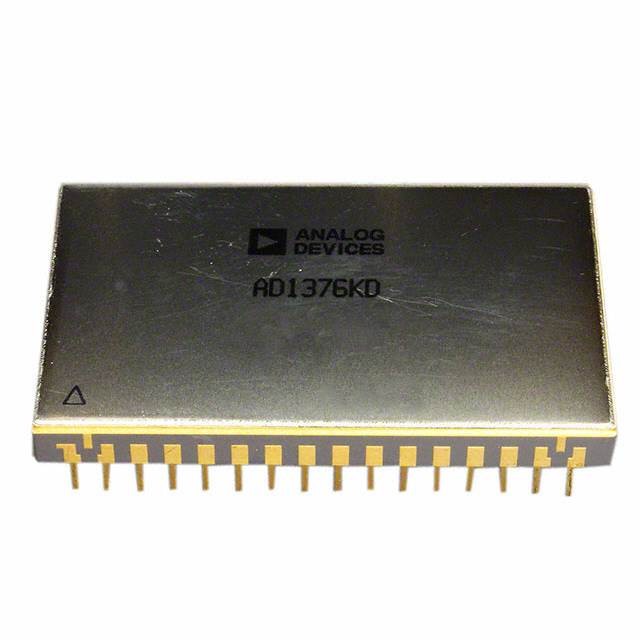ADADC71JD
Product Overview
- Category: Analog-to-Digital Converter (ADC)
- Use: Converts analog signals into digital data for processing and analysis
- Characteristics: High resolution, fast conversion speed, low power consumption
- Package: Integrated circuit (IC)
- Essence: Converts continuous analog signals to discrete digital values
- Packaging/Quantity: Available in surface mount packages, quantity varies based on supplier
Specifications
- Resolution: 16 bits
- Conversion Speed: Up to 1 Mega-Samples per second (MSPS)
- Power Supply Voltage: 3.3V
- Operating Temperature Range: -40°C to +85°C
- Input Voltage Range: 0V to Vref (Reference Voltage)
Detailed Pin Configuration
The ADADC71JD has a total of 28 pins. The pin configuration is as follows:
- VDD: Power supply voltage input
- VREF: Reference voltage input
- AGND: Analog ground
- VIN: Analog input voltage
- CLK: Clock input
- CS: Chip select input
- DOUT: Digital output data
- DGND: Digital ground
- SDO: Serial data output
- SDI: Serial data input
- SCLK: Serial clock input
- RESET: Reset input
- PD: Power-down input
- REFSEL: Reference voltage selection input
- AIN1: Analog input channel 1
- AIN2: Analog input channel 2
- AIN3: Analog input channel 3
- AIN4: Analog input channel 4
- AIN5: Analog input channel 5
- AIN6: Analog input channel 6
- AIN7: Analog input channel 7
- AIN8: Analog input channel 8
- AIN9: Analog input channel 9
- AIN10: Analog input channel 10
- AIN11: Analog input channel 11
- AIN12: Analog input channel 12
- AIN13: Analog input channel 13
- AIN14: Analog input channel 14
Functional Features
- High-resolution conversion with 16-bit accuracy
- Fast conversion speed of up to 1 MSPS
- Low power consumption for energy-efficient operation
- Wide input voltage range from 0V to Vref
- Serial data output for easy interfacing with microcontrollers or other digital devices
- Reference voltage selection for flexible operation
Advantages and Disadvantages
Advantages: - High resolution provides accurate digital representation of analog signals - Fast conversion speed allows for real-time data acquisition - Low power consumption reduces energy usage and heat generation - Wide input voltage range accommodates various signal levels - Serial data output simplifies integration with digital systems
Disadvantages: - Limited number of analog input channels (14 in total) - Requires an external reference voltage source for proper operation
Working Principles
The ADADC71JD operates based on the principle of successive approximation. It samples the analog input voltage, compares it to a reference voltage, and generates a digital code that represents the input voltage. This process is repeated at a high speed to convert continuous analog signals into discrete digital values.
Detailed Application Field Plans
The ADADC71JD is commonly used in applications where high-resolution analog-to-digital conversion is required. Some potential application fields include:
- Industrial automation: Monitoring and control systems that require precise measurement of analog signals.
- Medical equipment: Accurate digitization of physiological signals for analysis and diagnosis.
- Test and measurement: Data acquisition systems that capture and process analog signals with high fidelity.
- Audio processing: Conversion of analog audio signals into digital format for signal processing and storage.
Detailed and Complete Alternative Models
- ADADC72JD: Similar to ADADC71JD but with higher resolution (18 bits).
- ADADC73JD: Higher-speed version of ADADC71JD with a conversion rate of 2 MSPS.
- ADADC74JD: Lower-resolution variant of ADADC71JD with 12-bit accuracy.
These alternative models offer different specifications and features to cater to specific application requirements.
Word count: 457 words
Lista 10 Vanliga frågor och svar relaterade till tillämpningen av ADADC71JD i tekniska lösningar
Sure! Here are 10 common questions and answers related to the application of ADADC71JD in technical solutions:
Q: What is ADADC71JD? A: ADADC71JD is a high-speed analog-to-digital converter (ADC) manufactured by Analog Devices.
Q: What is the resolution of ADADC71JD? A: ADADC71JD has a resolution of 16 bits, allowing it to convert analog signals into digital values with high precision.
Q: What is the sampling rate of ADADC71JD? A: ADADC71JD has a maximum sampling rate of 250 MegaSamples per second (MSPS), enabling fast and accurate data acquisition.
Q: What is the input voltage range of ADADC71JD? A: The input voltage range of ADADC71JD is typically ±2.5 volts, making it suitable for a wide range of analog signal levels.
Q: Does ADADC71JD support differential inputs? A: Yes, ADADC71JD supports both single-ended and differential inputs, providing flexibility in signal conditioning.
Q: Can ADADC71JD be used in low-power applications? A: Yes, ADADC71JD features a power-down mode that reduces its power consumption when not actively converting signals.
Q: What is the interface of ADADC71JD? A: ADADC71JD uses a serial peripheral interface (SPI) for communication with microcontrollers or other digital devices.
Q: Is ADADC71JD suitable for high-frequency applications? A: Yes, ADADC71JD has a wide bandwidth and excellent dynamic performance, making it well-suited for high-frequency applications.
Q: Does ADADC71JD have built-in digital filters? A: No, ADADC71JD does not have built-in digital filters. However, it can be combined with external filters for specific signal conditioning requirements.
Q: What are some typical applications of ADADC71JD? A: ADADC71JD is commonly used in various applications such as communications systems, medical imaging, industrial automation, and scientific instrumentation, where high-speed and high-resolution analog-to-digital conversion is required.
Please note that the answers provided here are general and may vary depending on specific implementation requirements.


